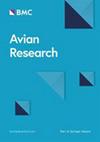离家出走:意大利中部蒙塔古小鹞的早期生活运动和空间使用
IF 1.7
2区 生物学
Q1 ORNITHOLOGY
引用次数: 0
摘要
评估动物迁徙模式的个体差异和变异性,对于加深我们对迁徙策略的进化和本体发育的理解至关重要。在长途迁徙物种中,羽化后的幼鸟通常需要在极其有限的时间内学习生存的基本技能,并为迁徙做准备,而这可能是它们一生中最危险的阶段。因此,收集迁徙前这一关键阶段的详细运动动态信息对于了解迁徙物种在不同环境下制定的解决方案至关重要。在此,我们使用高分辨率 GPS/GSM 发射器收集了出生在意大利中部的七只蒙塔古鹞(Circus pygargus)幼鸟的运动生态学信息,研究了它们生命的早期阶段,即羽化后依赖期(PFDP)和迁徙前阶段(PMP),直至秋季迁徙。雏鸟羽化后,个体在家园范围大小、日行走距离(6.88 ± 11.44 km/日)、离巢距离(1.45 ± 2.8 km)和PFDP长度(23.3 ± 5.3天)方面均表现出很高的变异性(空间和时间)。随着 PFDP 的进行,在产地的停留时间明显减少,而在产地的再次逗留时间间隔则明显增加。在PMP期间,不同个体探索的区域和离巢的距离(最大值达320.8千米)各不相同,尽管不同个体每天探索的距离(27 ± 40千米/天)以及旅行(60.7%)和觅食(39.3%)之间的时间分配相似。PMP持续了38 ± 14天。觅食地点的土地覆盖成分主要是农田(∼78.2%),但不同个体对栖息地的利用有所不同。超过76%的觅食地点位于保护区之外。这项以个体为基础的追踪研究是一种新颖的方法,它改进了之前基于对蒙塔古鹞早期生活阶段的实地研究的知识。个体间运动模式的高变异性、大范围的探索性运动以及保护区网络外的觅食地点使得标准保护措施的应用变得困难,从而引发了对意大利这一脆弱迁徙物种的长期保护的担忧。本文章由计算机程序翻译,如有差异,请以英文原文为准。
Moving away from home: Early life movements and space use in juvenile Montagu’s Harriers (Circus pygargus) from central Italy
Assessing individual differences and variability in animal movement patterns is essential to improve our understanding of the evolution and ontogeny of migratory strategies. In long-distance migratory species, fledged juveniles often rely on an extremely restricted time span to learn the essential skills for survival and to prepare for migration, possibly the most risky phase of their lives. Collecting detailed information on the dynamics of the movements during the crucial pre-migratory phase is hence essential to understand the solutions developed by migratory species in different environmental contexts. Here, we used high-resolution GPS/GSM transmitters to collect information on the movement ecology of seven juvenile Montagu's Harriers (Circus pygargus) born in central Italy, investigating their early life stages, namely the post-fledging dependence period (PFDP) and the pre-migratory phase (PMP), until autumn migration. After fledging, individuals showed high variability (both in space and time) in home range size, daily distances covered (6.88 ± 11.44 km/day), distance from the nest (1.45 ± 2.8 km) and PFDP length (23.3 ± 5.3 days). Residence time at the natal site significantly decreased, while time interval between revists in the natal area significantly increased, as the PFDP progressed. During the PMP, explored areas and distance from the nest (max value up to 320.8 km) varied among individuals, despite daily distances covered (27 ± 40 km/day) and time allocation between traveling (60.7%) and foraging (39.3%) were similar across individuals. The PMP lasted 38 ± 14 days. Land cover composition of foraging locations was mostly represented by agricultural lands (∼78.2%), though habitat use differed among individuals. More than 76% of such locations were outside protected areas. This individual-based tracking study represents a novel approach that improves previous knowledge based on field studies on the early life stages of the Montagu's Harrier. High inter-individual variability in movement patterns, broad-range exploratory movements and foraging locations outside the protected area network make the application of standard conservation measures difficult, raising concerns about the long-term preservation of this vulnerable migratory species in Italy.
求助全文
通过发布文献求助,成功后即可免费获取论文全文。
去求助
来源期刊

Avian Research
ORNITHOLOGY-
CiteScore
2.90
自引率
16.70%
发文量
456
审稿时长
46 days
期刊介绍:
Avian Research is an open access, peer-reviewed journal publishing high quality research and review articles on all aspects of ornithology from all over the world. It aims to report the latest and most significant progress in ornithology and to encourage exchange of ideas among international ornithologists. As an open access journal, Avian Research provides a unique opportunity to publish high quality contents that will be internationally accessible to any reader at no cost.
 求助内容:
求助内容: 应助结果提醒方式:
应助结果提醒方式:


